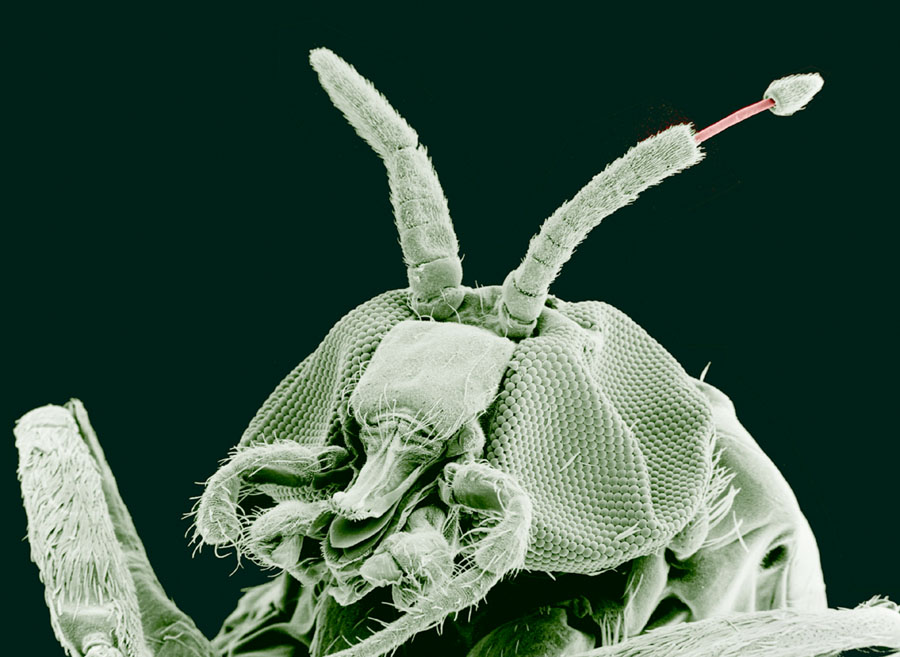(Photo: electron micrograph of a blackfly with Onchocerca parasite, credit:USDA)
The idea of sitting in a field and letting blackflies potentially carrying an unpleasant disease bite you sounds like a job best avoided, yet this is the way in which populations of blackflies carrying the river blindness parasite Onchocerca are monitored in Sub-Saharan Africa. Research is on to try and find an alternative and I heard about one study at the ISNTD Bites seminar in London recently. ISNTD Bites brings together multidisciplinary experts to form partnerships and exchange information about neglected vectorborne diseases.
Using people as bait for blackflies “is a bit like searching for landmines by sending someone out to walk in the minefield” said Ryan Young of the University of South Florida, presenting his study on developing an alternative bait at the seminar.
Ryan’s work is built on the finding that worn clothes and a blue or black sticky screen work almost as well as people as a bait to catch the flies. This is good, but for scientific surveys that can be compared you need a consistent bait, argues Ryan, and people vary in their attractiveness to blackflies. He and his team have therefore been trying to create a chemical bait. They began by analysing the chemicals in human sweat to try and pinpoint those that are most attractive to blackflies.
Ryan and his team analysed the chemicals in sweat samples collected from 3 men and purified the main components. The analysis showed how unique our sweat profiles are. There were over a thousand compounds to analyse but only 10% of them were found in more than one person. The researchers found 29 compounds that all 3 men had in common. They tested these compounds on captured female blackflies from Africa and from Mexico to see what they liked best and made a cocktail of the most attractive compounds. The African blackfly species was attracted to hexanoic acid, heptanoic acid, octanoic acid, nonanoic acid, 1-decanal, and acetophenone. The Mexican species was attracted to a slightly different set of chemicals. Ammonium bicarbonate also known to be attractive to blackflies was included in the mix as well.
Ryan and his team developed a low tech robust trap system that could be easily used to do surveys in remote parts of Africa. They came up with a system using reusable plastic beads, nylon tights (pantyhose) and a blue or black sticky screen. The reusable plastic beads are soaked in a mixture of the 8 chemicals above and tied up in the nylon tights (pantyhose). As well as the experimental cocktails, Ryan and the team also added a source of carbon dioxide (baker's yeast and a sugar solution). The bait was then attached to the screen. They reckoned this trap was good for about 5 days.
Surveys done with the experimental cocktails were promising and the screens worked well. The chemical mixes attracted about 3 times more flies than carbon dioxide alone. The team is now testing more chemicals to see if they can improve on the current mix.
When it is all working Ryan hopes that doing a survey would just involve posting a capsule of the chemical mix to the teams in the field who would than add it to the plastic beads and assemble the traps at the desired locations.
And even better, the volunteers who are now used to attract blackflies are not out of a job, because they are needed to collect the flies and set the traps.
Read Ryan‘s paper at:
Young RM, Burkett-Cadena ND, McGaha TW Jr, Rodriguez-Perez MA, Toe´ LD, et al. (2015) Identification of Human Semiochemicals Attractive to the Major Vectors of Onchocerciasis. PLoS Negl Trop Dis 9(1): e3450.
Sign up to the Global Health Knowledge Base newsletter for more blogs, news and database access:
Further Reading
Identified from Global Health Database
Optimization of the Esperanza window trap for the collection of the African onchocerciasis vector Simulium damnosum sensu lato.
Toé, L. D.; Koala, L.; Burkett-Cadena, N. D.; Traoré, B. M.; Sanfo, M.; Kambiré, S. R.; Cupp, E. W.; Traoré, S.; Yameogo, L.; Boakye, D.; Rodríguez-Pérez, M. A.; Unnasch, T. R.; Elsevier B. V., Amsterdam, Netherlands, Acta Tropica, 2014, 137, 39-43, 37 ref.
Subscribers use this link: http://www.cabdirect.org/abstracts/20143300763.html
Development of a novel trap for the collection of black flies of the Simulium ochraceum complex.
Rodríguez-Pérez, M. A.; Adeleke, M. A.; Burkett-Cadena, N. D.; Garza-Hernández, J. A.; Reyes-Villanueva, F.; Cupp, E. W.; Toé, L.; Salinas-Carmona, M. C.; Rodríguez-Ramírez, A. D.; Katholi, C. R.; Unnasch, T. R.; Public Library of Sciences (PLoS), San Francisco, USA, PLoS ONE, 2013, 8, 10, e76814, 46 ref.
Subscribers use this link: http://www.cabdirect.org/abstracts/20143032422.html
Related News & Blogs
One Health working will improve health and well-being of us all: plant, animal, human and ecosystem!
For One Health Day November 3, 2016, CABI editor Wendie Norris blogs about “One Health beyond early detection and control of zoonoses” an RSTMH 2016 talk by CABI author Esther Schellling (Swiss Tropical Public Health). Describing research projects on nomadic pastoralists in Chad and Rift Valley Fever (RVF) control in Kenya, Esther drew attention to the need for interdisciplinary studies to include an evaluation of One Health working, involvement of social scientists, engagement of key stakeholders. Tellingly she provided a cost-benefit analysis to society of controlling zoonoses when the disease is in its animal host before it infects human beings.
28 October 2016


